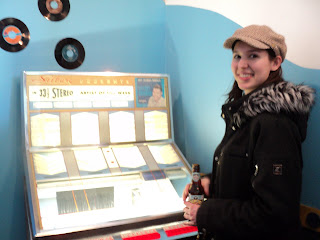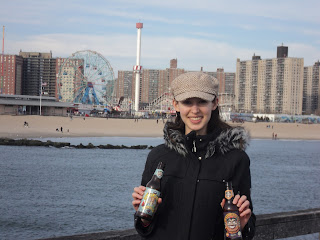So, I decided it would be worth eight bucks to go to the book launch for the second (apparently radically different) edition of Rethinking Contemporary Art & Multicultural Education (Routledge) at the New Museum featuring New Museum curator Eungie Joo, artists Kara Walker and Lan Tuazon, and Yale associate Dean for the Arts Susan Cahan. Not the least after hearing a former New Museum curator talking about during their time there being witness to this project taking 'forever' to make. Well, seeing as the speakers led off with jokes about how long it took to see this second edition project through to completion (Kara Walker's current jr high school kids being unborn, world events unfolding between the first and second editions, etc,) it really seems that was the case. However, besides being fully aware that this was a long simmering project, I really didn't know much about the project and was hoping that the book launch/lecture would provide some insight into the material.
Hm. Should've just read a synopsis on Amazon I guess, because this talk did anything but explain the contents of the book. That being said, it was an incredible informative and enlightening window into the direction of contemporary arts education. After the initial shout-outs to the publisher, Deutsche Bank, Aggie Gund, and other arts sponsors and sponsors of the book, Eungie Joo plunged into the thankless task of detailing for the lecture attendees the countless updates and differences between the two editions, a bit of history about how the two books were made (the first was from the extremely difficult to get Challenge 3 grant that provided them with a cool 1.1 million,) and some other details regarding the members of the board facing us and assisting with essays, editing the publication, etc. An interesting facet of the talk for me was that this was a lecture of multiculturalism and art being led by four women, all of varying backgrounds (but all women nonetheless) discussing the relevance of applying contemporary art to pedagogical use. I still feel like (and Kara Walker touched on this) even 40 years ago it would have been a panel of all white men discussing the need for 'multiculturalism in art' (not that that would seem a bit hypocritical...!)
But, enough of injecting my opinion. The discussion turned over to Susan Cahan, book's editor (along with Zoya Kocur, starting co-editor) who led off with the telling statement "this second edition is totally different from the first edition" and proceeded to expound on said differences by contrasting events that had occurred between the two editions, as well as providing background for the first edition. The biggest issue was that 15 years had spanned the difference between the two editions (not so long in the real world, an aeon by contemporary arts' standards.) She rehashed the trail of the first book, tracing roots from the Art Worker's Coalition (AWC) and the changing role of a developing multicultural American Art world (as opposed to the immediate post-WWII white male dominated Abstract expressionist scene, for instance.) She then traced the New Museum back to its roots as a dream Marcia Tucker put into effect after being fired from the Whitney Museum and assembling a board (and museum!) out of thin air back in 1977. She then cites Ed Jones joining the New Museum as a turning point, and discussed the importance of social issues in the art world and addressing those issues within the framework of exhibitions and contemporary art. Eventually the conversation came to the link between social justice and contemporary art, and the need to share contemporary art with everyone and not just allow it to be holed up like art has been for centuries for the wealthy and privileged, but by everyone for everyone. She cited the rising place of Social Justice in art and art institutions by charting the opening and progress of the Studio Museum in Harlem (1967) and El Museo del Barrio (1968.)
Next, Eungie Joo opened the floor to Lan Huatzon for her thoughts on her contributions to this edition. Lan cited influences ranging from Adrian Piper's "Mythic Male Being" (when she cross-dressed as a tough looking African-American male and place snapshots of this figure juxtaposed with personal diary entries) to Andria Frazier's statement "Today I'm not a person, I'm an object and a work of art." She then posed the question: what criteria is there to accept an object/being as art? One statement of Lan's that really stuck with me was later, when she posed the answer that contemporary art forces you to be aware of the present culture. Finally, she quoted a statement decrying contemporary art as a field structure around the logic of contradiction. I think Lan brought an academic perspective to the discussion.
Eungie Joo opened the floor to Kara Walker to discuss her part in the book. Kara did her audience the favor of tracing her career through art school and how having a lack of predecessors helped her more clearly identify herself through her artwork. She discussed being affected by studying civil rights movements and tracing the evolution of African-American culture through the 1960s and 70s. She emphasized the importance of minority self-reflection and culturally reflective art marking. She also addressed the issue of making relevant art while avoiding propagating power imbalances... addressing and responding to the 'art' of her white male predecessors while reacting in a way genuine to herself. She talks about the element of provocation in art (fitting for discussing the subject matter of her art, such as her cartoonish horror illustrations of the antebellum South, for instance) and the place of social activism in contemporary art.
Finally, the whole talk became open to a question and answer round, which more or less dissolved into a roundtable discussion amongst the panelists. Interesting tidbits during this panel talk included a snippet about all textbooks being tested by Texas audiences at Prentice Hall publishers (apparently Texas readers can't handle 'contemporary art' or 'multiculturalism', at least not outside of Austin I assume..?) the use of the word "multicultural": its benefits and challenges, and issues of diversification versus marginalization. The issue of the point artists were currently in their career when represented in the two editions was also raised; in the first edition, most artists were caught early in their careers, or naive artists were included. In the second edition, mid-career and established artists were included in the interest of making up for lost time, essentially. Susan also mentioned that the book primarily addresses the American art scene, with peripheral mention of international artists. A recurring theme was race and social identity; Eungie Joo, for example, questioned by the racial stereotypes challenged in Kara Walker's work can be recognized and related to by students in junior high school even now. Kara Walker cited an experience she had in Brazil, where a classroom of kindergarten students split up and made skits addressing the issue of AIDS. All the panelists seem to agree that the same people digesting art should be represented by those creating it, and that art should be recognized as open to everyone, not just a playground for the privileged.
Altogether, the lecture was a good intro to modern leading into contemporary issues of social justice as reflected in contemporary art and discussions of that art. As for the book, well, I can rest easy knowing that I know as little about it as I did before even attending the talk. At least I have some leads on artists that play a role in Kara Walker's oeuvre, though (Fred Wilson, anyone?)

 .....well, that image was quickly smashed, as when I got there at 9 pm I was ID'd, then
.....well, that image was quickly smashed, as when I got there at 9 pm I was ID'd, then I began to notice that after 10 pm there was a line outside the door..but c'est la vie, it was opening weekend! I also gradually noticed a bit of a wait to play the arcade games, but hey, there's always the beer right?....unless you brought a credit card, in which case, you had to wait for the machine to be up and running again, since it broke down.
I began to notice that after 10 pm there was a line outside the door..but c'est la vie, it was opening weekend! I also gradually noticed a bit of a wait to play the arcade games, but hey, there's always the beer right?....unless you brought a credit card, in which case, you had to wait for the machine to be up and running again, since it broke down.
































